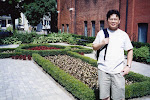leaves turn through
yellow, orange, red, purple ...
back home again !
thanksgiving prayer
with each word I get closer
to my inner child
a No Politics sign
on the dining room wall ...
turkey and ham dinner
thanksgiving leftovers
this relief when things remain
half-spoken
Thanksgiving, as it tends to be celebrated, is the most honest American holiday: all appetite, no apology... Thanksgiving just asks us to be hungry together, and then to eat. In any year, this would be a potently simple path to commonality; it might be the last truly unifying experience available to us as Americans. This year, sitting down for a feast in a time and a place and a nation that seems to be actively working to become more brutal, more indifferent, more willing to make people suffer for the sin of being poor or sick or born in the wrong skin or to the wrong parents or on the wrong side of an arbitrary line, the absurdity of it all is amplified. We feed others, we feed ourselves, and what else is there? At the table, at least, we can control something: the menu, the rituals, whatever small ferocious beliefs we hold about the holiday itself.
Added: Trump Empire, Inc, LXIV
written in response to the Convicted Felon's "Gilded Age" proclaim/obsession
the first
Black Friday
closing store sale
shiny Christmas trees
made of Louis Vuitton bags
Added:
doors burst open
in the early morning
kids wail in strollers
with their jackets zipped tight
as Black Friday sale signs flap
Added:
one power blink
another and another
this Cyber Monday
I gaze up from the screen
to ten thousand stars
FYI: "Power blinks are brief service interruptions, but they’re typically caused by a fault (short circuit) on a power line or a protective device that’s working in reaction to the fault. Faults can occur through a variety of instances, like squirrels, birds or other small animals contacting an energized power line; tree branches touching a power line; or lightning and other similar events. In fact, when it comes to power disruptions caused by critters, squirrels 🐿️ 🐿️ 🐿️reign supreme."
Added: Trump Empire, Inc, LXV
tower after tower
of Trump 2028 hats
store closing sale




